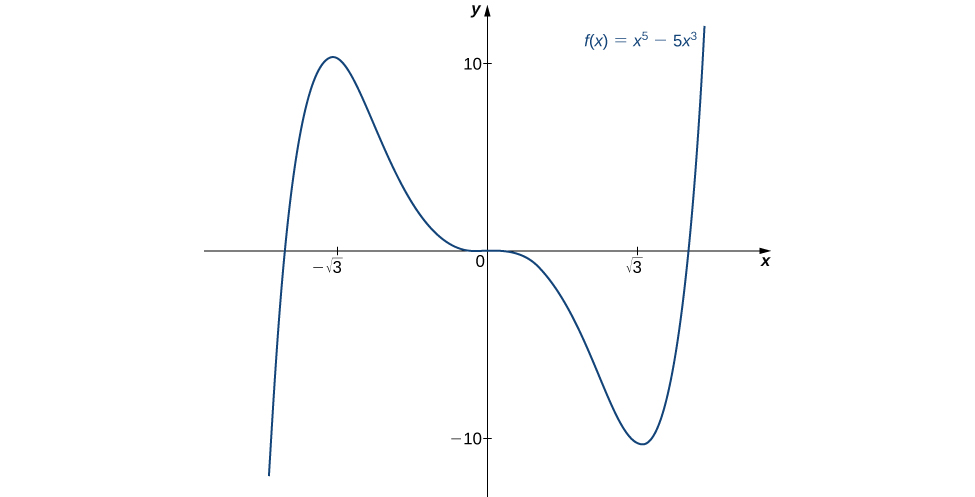Learning Outcomes
- Explain the relationship between a function and its first and second derivatives
- State the second derivative test for local extrema
The first derivative test provides an analytical tool for finding local extrema, but the second derivative can also be used to locate extreme values. Using the second derivative can sometimes be a simpler method than using the first derivative.
We know that if a continuous function has a local extrema, it must occur at a critical point. However, a function need not have a local extrema at a critical point. Here we examine how the second derivative test can be used to determine whether a function has a local extremum at a critical point. Let [latex]f[/latex] be a twice-differentiable function such that [latex]f^{\prime}(a)=0[/latex] and [latex]f^{\prime \prime}[/latex] is continuous over an open interval [latex]I[/latex] containing [latex]a[/latex]. Suppose [latex]f^{\prime \prime}(a)<0[/latex]. Since [latex]f^{\prime \prime}[/latex] is continuous over [latex]I[/latex], [latex]f^{\prime \prime}(x)<0[/latex] for all [latex]x \in I[/latex] (Figure 9). Then, by Corollary 3, [latex]f^{\prime}[/latex] is a decreasing function over [latex]I[/latex]. Since [latex]f^{\prime}(a)=0[/latex], we conclude that for all [latex]x \in I, \, f^{\prime}(x)>0[/latex] if [latex]x
Figure 9. Consider a twice-differentiable function [latex]f[/latex] such that [latex]f^{\prime \prime}[/latex] is continuous. Since [latex]f^{\prime}(a)=0[/latex] and [latex]f^{\prime \prime}(a)<0[/latex], there is an interval [latex]I[/latex] containing [latex]a[/latex] such that for all [latex]x[/latex] in [latex]I[/latex], [latex]f[/latex] is increasing if [latex]x<a[/latex] and [latex]f[/latex] is decreasing if [latex]x>a[/latex]. As a result, [latex]f[/latex] has a local maximum at [latex]x=a[/latex]. Since [latex]f^{\prime}(b)=0[/latex] and [latex]f^{\prime \prime}(b)>0[/latex], there is an interval [latex]I[/latex] containing [latex]b[/latex] such that for all [latex]x[/latex] in [latex]I[/latex], [latex]f[/latex] is decreasing if [latex]x<b[/latex] and [latex]f[/latex] is increasing if [latex]x>b[/latex]. As a result, [latex]f[/latex] has a local minimum at [latex]x=b[/latex].
Second Derivative Test
Suppose [latex]f^{\prime}(c)=0, \, f^{\prime \prime}[/latex] is continuous over an interval containing [latex]c[/latex].
- If [latex]f^{\prime \prime}(c)>0[/latex], then [latex]f[/latex] has a local minimum at [latex]c[/latex].
- If [latex]f^{\prime \prime}(c)<0[/latex], then [latex]f[/latex] has a local maximum at [latex]c[/latex].
- If [latex]f^{\prime \prime}(c)=0[/latex], then the test is inconclusive.
Note that for case iii. when [latex]f^{\prime \prime}(c)=0[/latex], then [latex]f[/latex] may have a local maximum, local minimum, or neither at [latex]c[/latex]. For example, the functions [latex]f(x)=x^3[/latex], [latex]f(x)=x^4[/latex], and [latex]f(x)=−x^4[/latex] all have critical points at [latex]x=0[/latex]. In each case, the second derivative is zero at [latex]x=0[/latex]. However, the function [latex]f(x)=x^4[/latex] has a local minimum at [latex]x=0[/latex] whereas the function [latex]f(x)=−x^4[/latex] has a local maximum at [latex]x=0[/latex] and the function [latex]f(x)=x^3[/latex] does not have a local extremum at [latex]x=0[/latex].
Let’s now look at how to use the second derivative test to determine whether [latex]f[/latex] has a local maximum or local minimum at a critical point [latex]c[/latex] where [latex]f^{\prime}(c)=0[/latex].
Example: Using the Second Derivative Test
Use the second derivative to find the location of all local extrema for [latex]f(x)=x^5-5x^3[/latex].
Watch the following video to see the worked solution to Example: Using the Second Derivative Test.
Try It
Consider the function [latex]f(x)=x^3-\left(\frac{3}{2}\right)x^2-18x[/latex]. The points [latex]c=3,-2[/latex] satisfy [latex]f^{\prime}(c)=0[/latex]. Use the second derivative test to determine whether [latex]f[/latex] has a local maximum or local minimum at those points.
Try It
We have now developed the tools we need to determine where a function is increasing and decreasing, as well as acquired an understanding of the basic shape of the graph. Next we discuss what happens to a function as [latex]x \to \pm \infty[/latex]. At that point, we have enough tools to provide accurate graphs of a large variety of functions.
Candela Citations
- 4.5 Derivatives and the Shape of a Graph. Authored by: Ryan Melton. License: CC BY: Attribution
- Calculus Volume 1. Authored by: Gilbert Strang, Edwin (Jed) Herman. Provided by: OpenStax. Located at: https://openstax.org/details/books/calculus-volume-1. License: CC BY-NC-SA: Attribution-NonCommercial-ShareAlike. License Terms: Access for free at https://openstax.org/books/calculus-volume-1/pages/1-introduction

